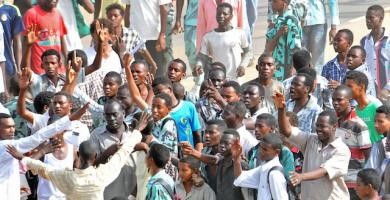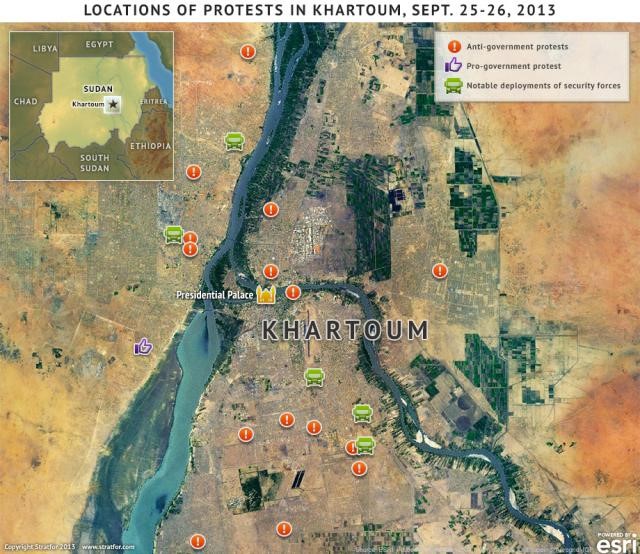Stratfor 2013-09-28
 Violent protests against the Sudanese government continued to spread across the country following noon prayers on Friday, after they began Sept. 22 in response to a government decision to cut fuel subsidies. If previous protests in Sudan are a guide, the demonstrations could carry on for several weeks, although a heavy crackdown by the regime will likely force protesters off the streets in the long run.
Violent protests against the Sudanese government continued to spread across the country following noon prayers on Friday, after they began Sept. 22 in response to a government decision to cut fuel subsidies. If previous protests in Sudan are a guide, the demonstrations could carry on for several weeks, although a heavy crackdown by the regime will likely force protesters off the streets in the long run.
While previous protests in Sudan have been limited mainly to Khartoum and its environs, the current round of demonstrations has expanded beyond the capital and has reached a higher level of violence than prior cases of similar unrest. On Sept. 27, the heaviest protests were witnessed early in the day in the city of Medani, 160 kilometers (100 miles) southeast of Khartoum, where protests originally erupted on Sept. 22.
On a tactical level, the larger geographic spread of the protests is straining the security forces that are scrambling to quell the violence. While the security forces were able to lock down most of north Khartoum during the first days of protests, large demonstrations took place there on Sept. 27 as well. South and east Khartoum, along with Khartoum's twin city Omdurman, remain restive.
Ahead of Friday prayers, the Sudanese government reinforced security in the capital by airlifting military forces from across Sudan into Khartoum overnight. These forces have deployed along the main bridges, around the presidential palace and main mosques, as well as in areas near the international airport in south Khartoum that have seen large

protests over the past few days.
The response of the security forces has also been particularly fatal, with reports of over 50 protesters killed since the demonstrations began. Other reports, which cite the presence of the National Congress Party militia, as well as the use of live ammunition by police, may reflect the government's commitment to a swift and brutal crackdown. However, the army, which has also been deployed to restore calm, has reportedly refrained from firing.
A new element in the current round of protests is the direct targeting of government infrastructure, which has not occurred in previous cases of unrest. Protesters have burned down several buildings belonging to the National Congress Party or security services, as well as several commercial venues. The need to protect key infrastructure will further restrain the ability of security forces to respond to protests over a wider area.
Protesters have also turned against the Sudanese Muslim Brotherhood, of which President Omar al Bashir is a member. The demonstrations have also had an adverse effect on the fuel and food prices, as attacks against fuel stations and closures of stores have caused shortages across Khartoum. Witnesses describe long waiting lines at operational fuel stations and bakeries.
In the past, the Sudanese government has demonstrated great resilience in the face of popular protests, and in those cases, the unrest fizzled out after several weeks. This time however, it remains to be seen how the regime will manage the unrest. Unconfirmed reports on Friday claimed that the governor of Gezira state had fled Medani and that several National Congress Party members and government ministers had relocated their families to Qatar, although the military reinforcements that arrived in Khartoum overnight will boost the government's ability to control the protests.
Another anomalous element in the current unrest is a lack of organization among opposition groups, which was present in previous protests. While groups such as Girifna, Sudan Change Now and others have been active on social media, they have not taken control of the demonstrations as they did in protests against the government in 2012. Mass demonstrations could be a springboard for furthering such organization, although so far the protests continue to be unorganized and rather spontaneous.
Courtesy : Stratfor (www.stratfor.com)
 Violent protests against the Sudanese government continued to spread across the country following noon prayers on Friday, after they began Sept. 22 in response to a government decision to cut fuel subsidies. If previous protests in Sudan are a guide, the demonstrations could carry on for several weeks, although a heavy crackdown by the regime will likely force protesters off the streets in the long run.
Violent protests against the Sudanese government continued to spread across the country following noon prayers on Friday, after they began Sept. 22 in response to a government decision to cut fuel subsidies. If previous protests in Sudan are a guide, the demonstrations could carry on for several weeks, although a heavy crackdown by the regime will likely force protesters off the streets in the long run.